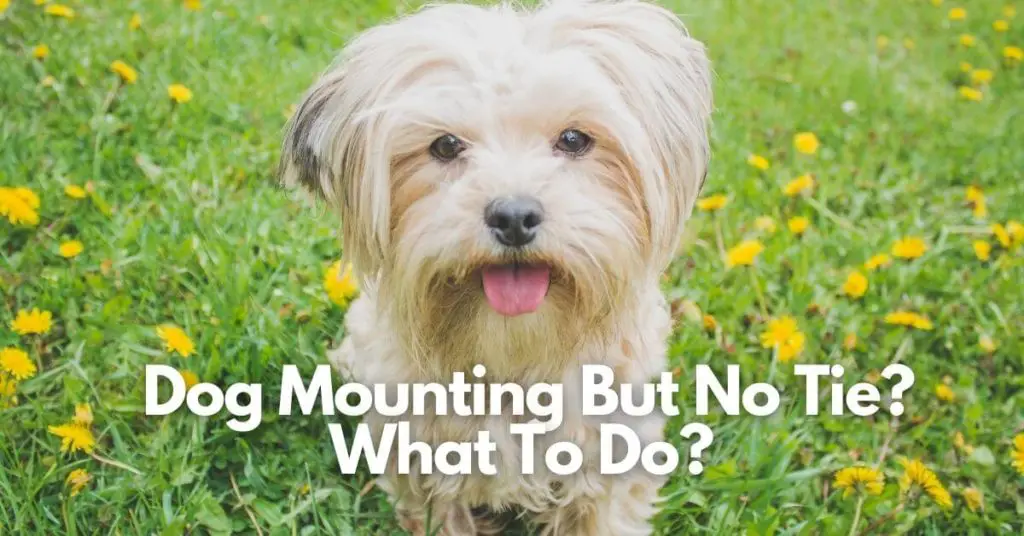Do you know that chances of your dog’s pregnancy increases if a proper tie has been formed? But what if dog mounting but no tie?
Well, you need not worry. If you want your dogs to mount and tie you can do a number of things to achieve this.
In this article, you’ll find out:
- 9 Reasons Why Dog Mounts But No Tie
- Is a tie necessary for a female dog to get pregnant?
- 9 Different ways to help a dog to mount and tie
- And more…

9 Reasons Why Dog Is Mounting But No Tie
If the dog is mounted, but with no tie, the female can still become pregnant. However, if no proper tie has been made, the chances of successful mating are reduced but not completely diminished. The male must ejaculate and safely transfer his sperm into the female in order to have a successful mating.
According to Veterian Key, a veterinary medicine publication, only one of 15 males successfully achieves a tie during the first year of life, even after as many as 39 mounts.
If the male dog removes his penis from the female before his bulbus glandis enlarges, the tie will not occur. This is also known as slip mating, and it occurs for a variety of reasons. The chances of pregnancy in slip mating is lower than when a tie is established as long as the male dog has ejaculated into the female dog.
1. The Male or Female Dog Is Not Interested or Ready To Mate
In some cases, either the male dog or the female dog may not be interested or entirely prepared to mate.
If a male tries to mount a bitch in proestrus (first stage), she will usually spin and snarl or snap back. The climax, the internal release of ova, and the start of genuine or “standing” heat, in which the bitch will allow herself to be mounted by an interested male, occur after ten days of proestrus.
During the second stage of her heat cycle, known as estrus, the female dog will be interested and ready for mating when she begins ovulation and produces viable eggs.
As a result, a tie is unlikely to occur if the female isn’t ready for mating yet and goes away from the male soon after he enters or if the male walks away before his organ becomes large enough for them to lock together.
Similarly, the male dog may not be interested to mate if the female dog is deemed as more dominant or if they are mating with dogs of a different breed.
2. Inexperienced or Young Male Dog
A male dog, in general, is always receptive to mating and tying and has little difficulty accomplishing the task. If this is your dog’s first mating session, it may need some guidance to establish a tie.
Minimize any disturbances in the surroundings and with a calm motion, help your dog stay in position after mounting the female dog. It may take several tries before your dog “gets” it.
3. Unfamiliar Environment
Inexperienced canines should be bred in a comfortable or familiar setting where they will feel at ease. Unfamiliar surroundings generate discomfort in dogs because they feel lost, and as a result, mating or a tie may not occur naturally.
You may let both the dogs socialize with each other at a fixed location for a period of time.This could be either homes of the male or female dog. This allows them to get comfortable with each other and the surroundings before mating.
4. Wrong Timing
For your dogs to have a successful mating, the environment and the timing are crucial. Wait till the right time arrives to start mating both dogs.
The age, sex, health, and size of the canines all play a role in determining the best time to mate them based on their fertility. Smaller breeds mature sexually before larger breeds.
5. Disturbing Surroundings
Distracting or noisy surroundings are another reason why dogs are not mating or tying. For example, dogs may be startled by a really loud noise.
Hence, if something in the environment has distracted the mating dogs, they will be unable to finish.
6. Dog’s Difference Sizes
The size difference between the male and female dogs is the most common reason for the male dog’s inability to mount the female.
Dogs who are physically incompatible with one another due to size and breed will have a considerably harder time completing the act, causing a lot of stress for both the dogs and their owners.
The solution is to always ensure that the sizes of both dogs are appropriate.
7. Stress & Anxiety
Stress and anxiety are other common causes of inability to tie. This is frequently due to the female moving around excessively during the act, making the stud’s job extremely tough.
Inexperienced dogs may feel uncomfortable during mating, resulting in stress that causes them to move more than they should.
8. Your dog may feel pain
It might be painful for the dogs if it’s their first time breeding. Any pain felt during coitus will almost certainly force the dogs to stop before the process is complete.
Female dogs, especially virgin dams, are more likely to experience pain from a tie. This is due to the female dog’s vaginal passage narrowing throughout this phase.
9. Swelling Of The Male’s Bulbus Glandis
Unless it’s their first or second copulatory tie, male dogs normally don’t suffer any pain. However, there is a situation in which the male may become uncomfortable. The enlargement of their “bulb” or bulbus glandis may be unfamiliar to them, and they may attempt to dismount from the female dog in panic.
Also Read: My Dog’s Bulbus Glandis Won’t Go Down! What Should I Do?
Can A Female Dog Get Pregnant When The Male Dog Has Mounted But Not Tied?
Many breeders assume that the mating has failed if the dogs aren’t locked, but you should always verify if ejaculation has occurred.
If the male dog mounts but no tying occurs, the female dog can still become pregnant if the male dog ejaculates. If no proper tie has been made, the chances of successful mating are minimized. Still, this does not rule out the possibility.
Also Read: What To Expect From Female Dog After Mating?
How To Help A Male Dog Mount A Female Dog And Tie?
Although mating is a natural process for dogs, you may help facilitate it by ensuring certain conditions are met.
1. Make Sure Both Dogs Are Ready To Mate
It’s crucial to keep track of the female dog’s fertility cycle so you can know when to breed her.
Therefore, before you try to breed your female dog, you’ll need to familiarize yourself with her menstruation cycles.
2. Keep Both Dogs Calm
It is recommended that both canines remain relaxed throughout the process in order to achieve successful copulation. Any stress placed on either dog will cause the natural flow of events to be disrupted, and the event may have to be rescheduled.
For instance, keeping an eye on them throughout the process may distract them, and they might get nervous.
To keep the two dogs calm, keep them in a quiet, enclosed environment that is private and free of distractions.
3. Allow Both Dogs To Socialize First Before Mating Starts
If the male and female dogs do not know each other, you must allow them to get familiar with one another prior to breeding. This will make them comfortable with one another and they’ll be entirely relaxed when the mating day arrives. Hence, the chances of successful mating and a tie will increase.
4. Guide Your Dog Throughout The Process
Although mating is a natural inclination, you may need to guide a younger male dog through the procedure if this is his first time, but try to restrict your involvement as much as possible.
Depending on the male or female size, you may need to support them up to allow penetration. If the male is new to the process, you may need to guide him in locating the proper entry place in the female.
You can keep an eye on things to ensure the dogs are doing what they should, but stay as far away from them as possible.
5. Keep Your Dogs Healthy
Animals, like humans, require good health to sustain fertility and have a successful pregnancy. You should feed your dogs a well-balanced diet and nutritious treats to keep them healthy.
You may also keep them healthy by having a feeding schedule in place. In addition to a nutritious diet, you should take your dogs for daily walks.
6. Hold The Dog And Guide It Gently
When the dog is ready, hold one hand in the female dog’s collar and the other around her ribcage to keep her steady. This makes it easier for the dog, and you may reassure the bitch if she seems anxious about the procedure.
If the bitch is a maiden bitch, which means she has never been mated before, she will prefer being courted for a longer amount of time.
7. Don’t Overfeed The Male Dog On A Mating Day
When a male dog’s stomach is full, and he’s sleepy, he’s less likely to be interested in mating.
Hence, you must refrain from overfeeding the male on a mating day until the two canines have successfully mated.
8. Make Sure Your Dog Is In A Healthy Weight Range
Female canines who are at a healthy weight have a better chance of conceiving and bringing the pregnancy to term than those who are underweight or obese.
Therefore, prior to breeding, make sure both dogs are healthy.
9. Encourage Dogs To Try Again
If the stud withdraws his penis from the female before his bulb enlarges, the coitus may not occur at all. This is also known as slip mating, and it occurs when a bitch isn’t quite ready to mate and moves as soon as the stud penetrates her. In such cases, simply try on another day.
According to the AKC’s Guide To Responsible Breeding, it recommends that dogs be bred between the 10th and 14th day after the onset of proestrus. For optimal chance of pregnancy success, mate every other day for a total of 2 to 3 times.
Hence, if the mating does not go well the first time, you can always try again.
.

